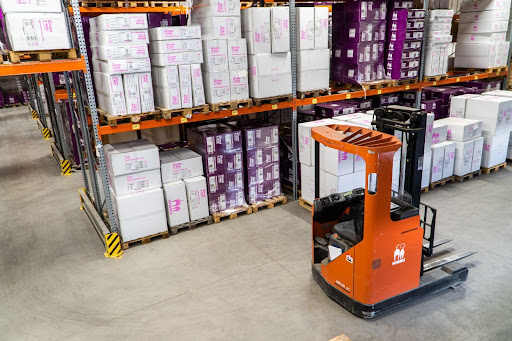Just-In-Time (JIT) Inventory Management has become increasingly popular among businesses in recent years, particularly as the global market has grown more competitive. This innovative approach to inventory control emphasizes a lean storage approach, prioritizing efficiency and cost reduction.
However, JIT Inventory Management also poses several challenges that companies must address in order to effectively implement this system. Read on as we discuss the benefits and challenges of JIT Inventory Management and explore strategies for optimizing this lean storage approach.
The JIT Inventory Management Philosophy
The JIT Inventory Management philosophy stems from the Japanese manufacturing industry, specifically the Toyota Production System (TPS). It is built on the idea of maintaining minimal inventory levels while still meeting customer demands.
Instead of stockpiling large quantities of raw materials or finished products, companies using the JIT system order materials only when needed for production or to fulfill customer orders.
Benefits of JIT Inventory Management
- Cost Reduction
One of the primary advantages of JIT Inventory Management is its potential for cost reduction. By maintaining minimal inventory levels, companies can significantly reduce their storage and warehousing costs. Additionally, a lean inventory reduces the risk of obsolescence and spoilage, further decreasing expenses.
- Increased Efficiency
A well-executed JIT system can streamline production processes, ensuring that materials and components arrive exactly when they are needed. This eliminates the need for companies to keep a buffer stock, which can lead to more efficient use of resources and improved cash flow.
- Enhanced Quality Control
By reducing inventory levels, JIT Inventory Management allows companies to focus on the quality of their products. With smaller inventory quantities, it becomes easier to identify and correct any quality issues before they become widespread problems.
- Improved Supplier Relationships
JIT Inventory Management requires close collaboration between companies and their suppliers. By working together to ensure the timely delivery of materials, companies can build stronger, more reliable supplier relationships, leading to better overall supply chain performance.
- Environmental Sustainability
Lean inventory practices can contribute to environmental sustainability by reducing the waste associated with overproduction and excess inventory. This can lead to a smaller environmental footprint for companies adopting JIT Inventory Management.
Challenges of JIT Inventory Management
- Supplier Dependence
One of the main challenges of JIT Inventory Management is the increased reliance on suppliers. With minimal inventory, companies become more vulnerable to disruptions in their supply chain. In the event of supplier delays or shortages, production can come to a complete and sudden halt, resulting in lost sales and damaged customer relationships.
- Increased Transportation Costs
As JIT Inventory Management relies on frequent, smaller shipments of materials, transportation costs can increase. Companies must carefully consider the cost-benefit analysis when implementing a JIT system, as the savings from reduced inventory storage may be offset by increased transportation expenses.
- Limited Flexibility
A JIT system requires precise planning and scheduling to ensure materials arrive exactly when needed. However, this can limit a company’s ability to respond to sudden changes in demand. If a company experiences a surge in orders, they may struggle to secure the necessary materials in time, leading to delays and dissatisfied customers.
- Complex Implementation
Implementing a JIT Inventory Management system can be a complex and time-consuming process. Companies must invest in advanced software systems and train employees to effectively manage the new system. Additionally, the success of JIT Inventory Management relies heavily on accurate forecasting and demand planning, which can be challenging for businesses.
Strategies for Overcoming JIT Inventory Management Challenges
- Diversify Supplier Base
To mitigate the risk of supplier dependence, companies should diversify their supplier base. By working with more than one supplier, businesses can naturally reduce the risks of supply chain disruptions and maintain a steady flow of materials.
- Implement Backup Plans
To address the limited flexibility of JIT Inventory Management, companies should develop contingency plans to respond to sudden fluctuations in demand. This may include maintaining a small safety stock of critical components or having alternate suppliers on standby. By preparing for potential disruptions, businesses can better adapt to changing market conditions without sacrificing customer satisfaction.
- Invest in Technology and Employee Training
The successful implementation of JIT Inventory Management depends on accurate forecasting and demand planning. Investing in advanced software systems and employee training can help improve the accuracy of forecasts and streamline the management of the JIT system. By ensuring that employees are well-versed in JIT principles and techniques, businesses can better manage their lean inventory.
- Collaborate with Suppliers and Customers
Open communication and collaboration with suppliers and customers are crucial for JIT Inventory Management. By sharing information about demand forecasts and production schedules, companies can better align their supply chain with customer needs. In turn, this can help minimize the risk of supply chain disruptions and improve overall efficiency.
- Monitor and Optimize the JIT System
Ongoing monitoring and evaluation of the JIT Inventory Management system are essential for ensuring its continued success. Companies should regularly assess the performance of their JIT system, identify areas for improvement, and make adjustments as needed. By continuously optimizing the system, businesses can maximize the benefits of JIT Inventory Management while minimizing its challenges.
Incorporating Third-Party Warehouse Fulfillment Organizers
Partnering with third-party warehouse fulfillment organizers is an effective way to implement JIT Inventory Management and lean storage approaches for retailers or e-commerce businesses.
These organizations specialize in managing inventory, quality control, and distribution and shipping, streamlining the JIT process and helping businesses overcome some of the challenges associated with this approach. Warehousing and strategic marketing campaigns play critical roles in ensuring that products are stored efficiently, distributed effectively, and made available to customers when needed.
Benefits of Working with Third-Party Warehouse Fulfillment Organizers
- Expertise and Experience
Third-party fulfillment providers have extensive experience in managing JIT Inventory Management systems. They possess the necessary skills, technology, and infrastructure to effectively manage lean inventory storage and order fulfillment, reducing the complexity of implementing JIT systems for businesses.
- Scalability
As businesses grow and order volumes increase, third-party warehouse fulfillment organizers can quickly scale their operations to accommodate the changing needs of their clients. This allows retailers and e-commerce businesses to maintain a lean inventory storage approach without sacrificing their ability to meet customer demands.
- Reduced Transportation Costs
By partnering with a third-party fulfillment provider, businesses can consolidate their inventory and shipments, potentially reducing transportation costs. This is especially beneficial when implementing a JIT system, where frequent, smaller shipments can lead to increased transportation expenses.
- Improved Flexibility
Third-party warehouse fulfillment organizers can provide businesses with greater flexibility in responding to fluctuations in customer demand. By maintaining relationships with multiple suppliers and having access to a larger pool of resources, fulfillment providers can help ensure that materials and products are available when needed.
- Focus on Core Competencies
By outsourcing inventory management and order fulfillment to a third-party provider, businesses can devote more time and resources to their core competencies, such as product development, marketing, and customer service.
Going Lean and Sustainable
JIT Inventory Management offers numerous benefits, including cost reduction, increased efficiency, enhanced quality control, improved supplier relationships, and environmental sustainability. However, companies must also be aware of the challenges that come with this lean storage approach, such as supplier dependence, increased transportation costs, limited flexibility, and complex implementation.
By adopting strategies like diversifying the supplier base, implementing backup plans, investing in technology and employee training, collaborating with suppliers and customers, and continuously monitoring and optimizing the system, businesses can effectively overcome these challenges and reap the rewards of JIT Inventory Management.
In today’s competitive global market, companies that can successfully implement a lean storage approach will be well-positioned to respond to changing customer demands and achieve long-term success.





